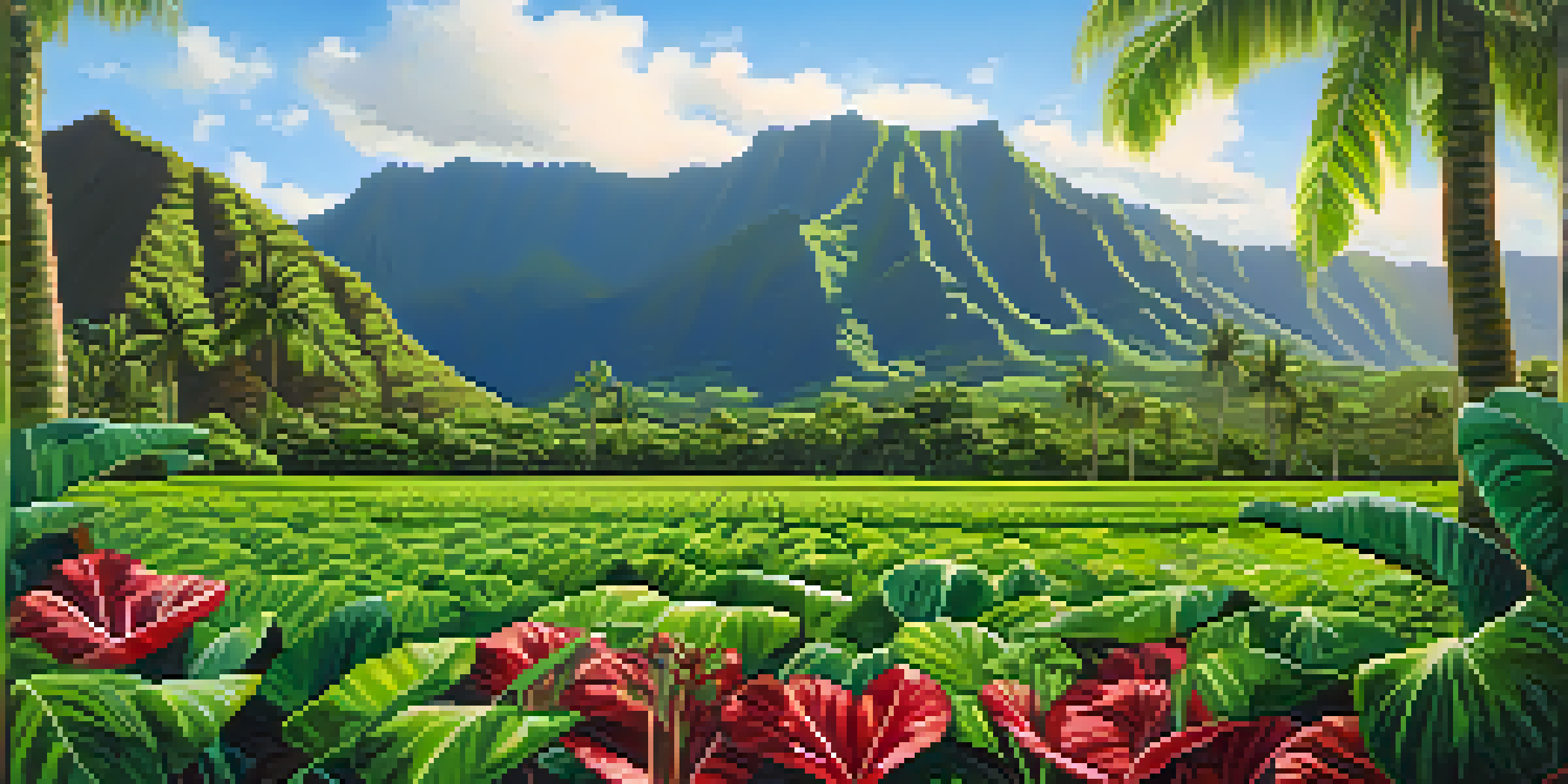Hawaii's Indigenous Practices and Their Role in Environmentalism

Understanding Indigenous Practices in Hawaii
Hawaii is home to rich indigenous cultures that have thrived for centuries, deeply intertwined with the land and sea. These practices, rooted in ancient traditions, emphasize respect for nature and sustainable living. For instance, the concept of 'malama 'aina' translates to 'to care for the land,' reflecting a holistic approach to environmental stewardship. This mindset not only nurtures the environment but also fosters a sense of community and belonging among the people.
'To care for the land is to care for ourselves.'
In indigenous Hawaiian culture, the relationship with the land is reciprocal; it’s not just about taking resources but also giving back. Stories, chants, and rituals are often centered around the natural world, highlighting the importance of maintaining balance. For example, the practice of 'kalo' (taro) cultivation showcases sustainable agricultural techniques that have been passed down through generations, demonstrating a profound respect for the earth's resources.
These practices are not just historical relics; they are essential to contemporary environmentalism. As the world grapples with climate change and ecological degradation, Hawaii’s indigenous knowledge offers valuable insights and solutions. By prioritizing sustainability and community, these practices hold the potential to guide modern conservation efforts.
The Role of 'Aloha Aina' in Environmentalism
'Aloha Aina,' meaning 'love for the land,' encapsulates the Hawaiian philosophy of environmental stewardship. This principle encourages individuals to protect not only the land but also the waters and skies, recognizing their interconnectedness. By fostering a deep emotional bond with nature, 'Aloha Aina' inspires action and responsibility towards environmental conservation. It urges people to view themselves as guardians, ensuring the health of the ecosystem for future generations.

This philosophy is evident in community-led initiatives that combat pollution and restore native habitats. For example, beach clean-ups and reforestation projects are often organized with a strong sense of collective responsibility. Participants engage in these activities not just for ecological benefits but as expressions of their love for their homeland. This engagement creates a powerful sense of unity, driving home the idea that caring for the environment is a shared mission.
Indigenous Practices Promote Sustainability
Hawaii's indigenous practices emphasize a respectful relationship with nature, offering valuable insights for modern environmentalism.
Additionally, 'Aloha Aina' fosters a cultural identity that emphasizes sustainability. By incorporating traditional practices into daily life, Hawaiians are not only preserving their heritage but also actively contributing to environmentalism. This cultural integration showcases how indigenous wisdom can inform modern practices, creating a sustainable future rooted in respect and love for the land.
Traditional Resource Management: Lessons for Today
Hawaiian indigenous practices include traditional resource management systems that offer valuable lessons for modern environmentalism. One such system is the 'ahupua'a,' a land division that stretches from the mountains to the sea, allowing for sustainable resource use across diverse ecosystems. This holistic approach ensures that each area is managed according to its unique ecological needs, promoting biodiversity and sustainability. It serves as a reminder that healthy ecosystems rely on thoughtful and systematic management.
'We do not inherit the earth from our ancestors; we borrow it from our children.'
Another aspect of traditional resource management is the practice of 'kapu,' which refers to restrictions or prohibitions designed to protect certain resources. For instance, specific fishing areas might be temporarily closed to allow fish populations to recover. These practices emphasize the importance of respecting natural cycles and understanding the limits of resource use. In today’s context, they highlight the need for regulations that balance human needs with ecological sustainability.
As we face pressing environmental challenges, these traditional practices can inform contemporary resource management strategies. By embracing indigenous wisdom, we can develop more sustainable systems that honor both nature and community. This approach not only enhances environmental health but also strengthens cultural ties, creating a holistic framework for conservation.
Cultural Revitalization and Environmental Advocacy
In recent years, there has been a resurgence of interest in Hawaiian cultural practices, which coincides with a growing movement for environmental advocacy. This cultural revitalization is not just about restoring traditions but also about empowering communities to take charge of their environmental futures. By integrating traditional knowledge into modern environmental campaigns, activists are fostering a deeper connection between culture and ecology.
For example, cultural practitioners are now leading efforts to educate younger generations about traditional practices such as farming and fishing. These educational initiatives not only preserve cultural heritage but also encourage sustainable practices that respect the land. By instilling a sense of pride in their cultural identity, these programs inspire youth to become stewards of their environment, bridging the gap between past traditions and future sustainability.
Aloha Aina Inspires Community Action
'Aloha Aina' fosters a strong emotional bond with the land, motivating collective efforts for environmental conservation and cultural identity.
Moreover, this revitalization has sparked collaborations between indigenous leaders and environmental organizations. By combining grassroots knowledge with scientific research, these partnerships create comprehensive strategies for conservation. This synergy showcases how traditional wisdom can significantly enhance modern environmental efforts, proving that cultural heritage and ecological health go hand in hand.
Indigenous Women: Leaders in Environmentalism
Indigenous women in Hawaii play a pivotal role in environmentalism, often serving as the backbone of community initiatives. They are not only custodians of traditional knowledge but also advocates for sustainable practices. Many women lead efforts to protect native species, restore ecosystems, and educate the community about environmental issues. Their unique perspectives and experiences enrich the dialogue around conservation and sustainability.
One inspiring example is the work of women-led organizations that focus on preserving native plants and traditional farming practices. These groups often organize workshops and events to share knowledge, fostering a sense of community and resilience. By empowering women to take leadership roles, these initiatives not only address environmental concerns but also promote gender equality and social justice within the community.
This leadership is essential, especially as climate change disproportionately affects vulnerable populations. Indigenous women are often at the forefront of advocacy, working tirelessly to ensure that their voices are heard in environmental decision-making processes. Their contributions highlight the importance of inclusivity in environmentalism, proving that diverse perspectives lead to more effective and sustainable solutions.
Challenges Facing Indigenous Practices Today
Despite the rich heritage of indigenous practices in Hawaii, modern challenges threaten their survival and effectiveness. Rapid urbanization, climate change, and globalization have all impacted traditional ways of life, leading to a disconnection from the land. As younger generations migrate to urban areas, there is a risk that traditional knowledge may fade away, leaving communities vulnerable to environmental degradation.
Additionally, ongoing struggles for land rights and recognition of sovereignty complicate efforts to implement traditional practices. Indigenous communities often face bureaucratic hurdles when attempting to reclaim ancestral lands or promote sustainable practices. This disconnection from their land can hinder the application of traditional ecological knowledge, making it essential to advocate for policies that support indigenous rights.
Indigenous Women Lead Environmental Efforts
Indigenous women in Hawaii play a crucial role in advocating for sustainable practices and preserving traditional ecological knowledge.
The challenge lies in finding ways to integrate traditional practices with contemporary environmental management. As awareness of these challenges grows, there is an opportunity for collaboration between indigenous communities and environmental organizations. By working together, they can ensure that the wisdom of Hawaii's ancestors continues to inform and inspire future generations in their quest for sustainability.
The Future of Indigenous Practices and Environmentalism
Looking ahead, the future of indigenous practices in Hawaii is intertwined with the broader movement for environmental justice. As more people recognize the value of traditional ecological knowledge, there is a growing emphasis on integrating these practices into contemporary environmental policies. This shift is crucial for creating resilient ecosystems that can withstand the impacts of climate change while honoring cultural heritage.
Education plays a vital role in this future, as it fosters a deeper understanding of indigenous practices among both locals and tourists. By promoting cultural awareness and appreciation, we can cultivate a stronger connection between people and the natural world. Initiatives that celebrate Hawaiian culture alongside environmental stewardship can inspire action and advocacy, creating a community of engaged citizens dedicated to sustainability.

Ultimately, the revival and application of indigenous practices offer a hopeful pathway toward a more sustainable future. By learning from the wisdom of Hawaii's indigenous peoples, we can create a more inclusive and holistic approach to environmentalism. Together, we can honor the land, celebrate its culture, and work toward a future that respects both the environment and its stewards.